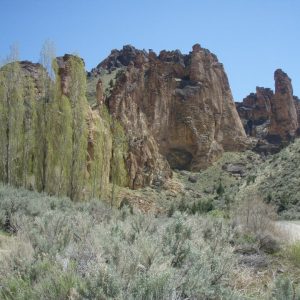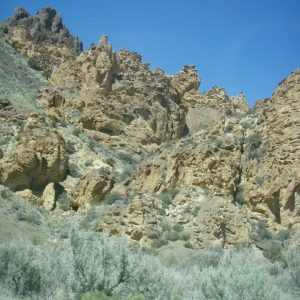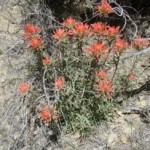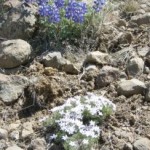Rain
Fire
Wild flowers
Monthly Archives: May 2013
Prairie Dogs, Pronghorns and Petroleum
So glad to get a CLM internship! I have been placed in the Vernal field office with the BLM. It is located in the beautiful Uintah Basin in Northeastern Utah. There is one other CLM intern placed here, so it has been nice to learn together.
In Vernal Utah, there is a lot of oil and natural gas development. The areas we have been to, so far, have been dotted with well pads. It is interesting to learn about the hopeful balance of resource use, conservation and recreation. I hope to learn more about the process of leasing land for oil development as the weeks go on.
Our work at the Vernal Field Office will be monitoring sensitive, threatened and endangered plant species populations and Seeds of Success work. The past three weeks we have been monitoring for three different species, all of which come with their own challenges. My favorite so far has been Schoencrambe argillacea (clay-reed mustard). It grows in nearly inaccessible places which made hiking sometimes exciting; including navigating through canyons and up steep slopes to find suitable habitat. It is a beautiful mustard, and I think the difficulty in finding it makes it even more endearing. Rare plant monitoring can be discouraging at times when we are not finding any plants, but it is exciting when we find new populations!
The weather has been mostly mild, but we did have snow the first week… and are having thunderstorms this week!
I am so grateful to have this opportunity as a CLM intern, and I am sure that I will learn a lot from my mentor and co-workers, as well as the landscape.
Spring in the San Bernardinos
Spring has finally arrived in the San Bernardino Mountains. It’s a drought year here in Southern California, but some plants are managing flowers. Many I’ve seen have crumpled in the heat and will not be producing a seed crop this year, but such is life in the mountains above the Mojave. I mentioned in my last entry that I was excited to see the spring-flowering plants that I missed due to my internship starting at the end of last May. I’ve seen all but two rare plants on my “to see” list while in Big Bear- so that’s pretty good!
Probably the most exciting news of this last month was a visit from my college advisor, Tass Kelso. She and her husband, George, had not yet seen the famous pebble plains of Big Bear and stopped by on a road trip to visit their family in Southern California. Tass is a Primulaceae expert and was interested in some pebble plain endemics that belong to that family; specifically a Dodecatheon and an Androsace species. We found both plants, the Dodecatheon was in flower and the Androsace was in fruit. As I understand it, neither of the species in question fully key into any of the currently acknowledged species of their respective genera. Botanists in the area have been referring to the Dodecatheon as D. hendersonii and the Androsace sp. as A. septentrionalis but both have some key morphological differences that have made Tass curious. She was thrilled to get specimens of both of her research subjects and was astounded that we saw about three of the endangered plants and five of the threatened/sensitive species found on the San Bernardino National Forest all in flower during the course of a four-hour tour! It was an absolute treat to be part of the conversations that afternoon between my CLM mentor and my advisor; both of whom I regard very highly.
As for my normal duties, I finally finished all of my data entry from last season and got caught up on the backlog of element occurrence data that was floating around the office from the hands of one intern to another. Color coding what I have entered into our geo-database made me feel like my effort was not in vain, as the slog of repetitive data entry will often make one feel. I really have accomplished a lot over this last year.
Another exciting aspect of my job recently was that I got the chance to participate in grant writing. I have always been interested in grant writing and was thrilled to be charged with the task of helping the Restoration Program Manager with applying for an $800,000 state OHV grant. I helped construct and edit two Soil Conservation Plans and reported on last year’s restoration accomplishments. The latter was made infinitely easier than it has been in the last few years, thanks to our new geo-database that myself and a fellow field technician created for our restoration program.
May will be my last month of being a CLM intern; we’ll see what it brings!
Lizzy Eichorn, San Bernardino National Forest
Internship in a Month and a Half
This’ll be my first and last blog post, as I’m filling in the month and a half of time left over from last summer’s CLM intern, who had to leave early.
Here at the C&O Canal National Park, things are busy, and many projects abound to keep a botanically inclined intern occupied. RTE surveys, Environmental Assessment vegetation inventories, and even a wetland delineation have been crammed into this month, increasing my botanical skills further. Perhaps the most import thing, however, was the search for Emerald Ash borer in the park. This European insect has killed millions of ash already in the Midwest, and has been increasingly spotted on the east coast. For an ash-heavy park such as the C&O canal, such an insect could be devastating.
Though my time here was short, the variety and importance of my tasks made the month and a half here invaluable, experience-wise, as well as providing further a way into the National Park Service.
I leave you with a photo of the wonderful Dwarf Larkspur, a State watchlist species for the state of Maryland.
Nearing the end
One week left. I’ve finished the main purpose for my extension, having digitized all disturbances within all of the Buffalo FO sage grouse core and connectivity. It took me quite a while, but it’s done. So now I’m just finishing up some loose ends from my previous extensions, going through old data, sorting problem range improvement files, and organizing for the next interns coming in. I was able to go see the sage grouse on their leks, which was very neat, but I think I enjoyed seeing the sharp-tailed grouse even more. They chase each other all over the place and then dance like crazy. Definitely fun to watch.
First weeks in Eastern Oregon
Before getting the CLM internship in Vale, Oregon, I imagined all of Oregon as being like Portland: rain, forests, rocky coastline. The eastern side of Oregon couldn’t be farther from this image. In fact, before coming here, I was surprised when I looked at a map and saw the amount of desert and scrubland in Oregon, as compared to the amount of forest. Vale is beautiful in a very different way from what I am used to. I think of the gently sloping, forested mountains of Appalachia (near where I come) as a kind of soft beauty. Vale is all yellow rock, volcanic remains, and then the amazingly hardy plants that somehow survive in this seemingly impenetrable landscape.
The wildlife in the desert is abundant and much more diverse that I would have expected. Already, we have seen ring-necked pheasants, a short-eared owl, golden eagles, pronghorn antelope, mule deer, quail, killdeer, a horned toad, marmots, and what seems like a million ground squirrels. Even with incredibly little rain and almost no shade, the scrubland teems with life.
I have only been here for a few weeks now and feel that I am getting a condensed crash course in sagebrush botany. I’m amazed at what I’ve been able to pick up already but I think that the botany skills that I am honing will be useful for whatever ecosystem I work in next. Our first sensitive plant to monitor: Hackelia cronquistii, a fragile white-blue borage with an affinity for north-facing slopes. After surveying several sites that had not been visited since the late 1980s and finding no Hackelia, we were enthusiastic to find one population of over 100 plants yesterday. Hopefully, it will be one of many to come.
One idea that I have learned quickly is the difference between a good quality hillside and a poor quality hillside. Perennial bunchgrasses hold the soil together and prevent erosion: they give slopes a bumpy, uneven look. On the other hand, cheat grass, an invasive annual grass, has managed to establish itself on many hills, especially after fires. It gives slopes an even, smooth, light green tint and usually dominates the ecosystem. When cheat grass takes over, few natives can co-exist.
I’m looking forward to continuing my crash course in botany and look forward to meeting the rest of the interns at the CLM workshop in June!
- Leslie Gulch
- Indian Paintbrush, a showy and iconic early flower
- Two common sagebrush inhabitants: Lupines and Phloxes
Oregon Spotted Frog Adventures!
Hello All,
This past month has been all about the secretive Oregon spotted frog that we have been putting much effort into gathering data upon and monitoring. As some out West may know, the Oregon spotted frog is a candidate species for endangered species listing under the Endangered Species Act. I believe it is going to be listed as a threatened or endangered species in the near future. Historically, the Oregon spotted frog’s range included British Columbia, Washington, Oregon, and California. Currently, it is estimated that about 78% of its former range has been lost and is found now only in small pockets within British Columbia, Washington & Oregon and is thought to be extirpated from California (http://www.fws.gov/oregonfwo/Species/Data/OregonSpottedFrog/).
This past week, my co-intern and I have been camping out in the Modoc National Forest in northern California searching for the Oregon spotted frog in what had been identified as suitable habitat in the previous year by the spotted frog biologist. We will be camping again this week for the second round of surveying. So far, we have found some great habitat in the Modoc National Forest, but sadly no frogs yet. After finding some prime habitat but no frogs it seems unlikely that we are going to find any there, but we will still try! It sure has been a beautiful place to be camping and hiking around in. We even saw some fresh black bear tracks this past week and found a snipe’s nest with eggs! There are so many great birds coming back for the breeding season as well, that are very exciting to see.
After this last week of frog surveying, we will be moving on to working with sucker fish that are native to the upper Klamath Basin, so many more exciting weeks to come!
One amusing lesson I learned this month is that Dodge Durangos may be large vehicles, but that doesn’t mean they have a high clearance. This lesson was learned after having gotten the vehicle stuck in snow on a back dirt road that wasn’t very deep at all. Luckily, our supervisor was with us so we had 3 hands on deck to get it out. On another amusing side-note, as I was pushing on the vehicle to help get it unstuck it started gaining momentum and my feet got hung up in the snow and I did a forward face plant in the snow! Definitely making for some memorable moments this month! 
That’s all for now folks, here are some photos from this week! 🙂
First impressions of Pine Hill Preserve
I am settling in to my CLM internship with the BLM Mother Lode field office, located in the Sierra foothills East of Sacramento. This is my second CLM internship, and it is very different from my first CLM internship. Last year I worked with the BLM in Alturas, California. Alturas is situated in the remote Northeastern corner of the state, with very few people and vast landscapes. The Mother Lode field office is based in El Dorado Hills, an affluent suburb of Sacramento. Botanically, it is very familiar to me, the oak woodland and chaparral are reminiscent of the mountains of my hometown, Santa Barbara. My internship is specifically concerned with the Pine Hill Preserve (PHP), a nature preserve managed by the BLM. PHP consists of just over 4,700 acres and was created primarily to protect eight species of rare plants. The unique Gabbro soil formation found on the preserve and surrounding areas hosts a unique assembly of plants. 740 plant species have been found here, which is ten percent of Californias total flora, meaning this small portion of the state is incredibly diverse. Of the eight rare plant species found at PHP, five are federally endangered and three occur nowhere else in the world. One species, Pine Hill Flannelbush (Fremontodendron decumbens), has only about 120 surviving individuals. 
Since my arrival last month, I have been learning about the management practices and conservation issues at PHP. The two main threats to the rare plants and their associated ecosystem are development and lack of fire, which go hand in hand. Much of the habitat for the Gabbro soil plants has been converted into roads, houses, and other development, which makes conservation ecology seem all the more relevant. Whereas last year, I would drive down rough dirt roads for miles to access field sites, at PHP it involves practically parking in peoples’ driveways. The ecosystem is fire adapted, and the rare plants require fire to be successful, whether for seed germination or simply the disturbance of the chaparral which creates more light and space to grow. Fire suppression threatens to eliminate the niche these plants have been evolved for. Due to the proximity to houses, broadcast prescribed burns are difficult at PHP; although my mentor Graciela Hinshaw is working on approving one. Instead of burns, fuel breaks are created with mechanical thinning, and the vegetation is burnt in small piles, as shown in the picture from 2011. One project I have been working on is monitoring some piles that were burnt last Fall to see which plants are coming back, and if any rare plants have germinated. The good news is that the rare plants respond well to mechanical thinning and burn piles. This gives the nearby houses fuelbreaks, which protect them from fire, and the rare plants are provided with a suitable habitat– a win-win, which can be hard to find in the conservation world.
I was also able to work at the BLM state office last week. The BLM California botanist, Christina Lund, is gone on a long term project, and Graciela has been taking on many projects for her. Graciela had me come to the state office to help with a literature search on several desert plants. Currently there are many renewable energy projects planned for BLM land in the California deserts. The main plant I researched was creosote bush, a ubiquitous shrub in that region. Lots of creosote will likely be bulldozed to build solar plants. Although the shrub isn’t much to look at, it has a fascinating natural history. It forms clonal rings of genetically identical “satellite plants” that grow radially at an extremely slow rate. The largest known ring, the “King Clone”, is 22 meters wide at its longest axis, and is estimated to be 11,700 years old! This may mean that that plant was one of the first to colonize the new land that opened up when glaciers receded and the Mojave desert formed, and has been growing there ever since. Anyway, Christina and others are working on establishing a minimum ring size to designate as protected. I was able to find some information and scientific articles, but it is a difficult question, since a creosote ring just one meter in diameter is already several times older than an old growth conifer. In any case it was interesting to do research for a project in the desert and learn about the ancient ecosystems there.
I have also been able to participate in some outreach events. This included guiding a botany class that visited a stunning parcel called Kanaka Valley , which is exploding with wildflowers. Graciela told me that before being aquired by the BLM, Kanaka Valley was slated to be developed into a golf course… something I am grateful did not happen!
Its been a busy first few weeks, and I anticipate many interesting projects to come!
Joe Broberg
Pine Hill Preserve intern
BLM MOLO Field Office
El Dorado Hills, CA














